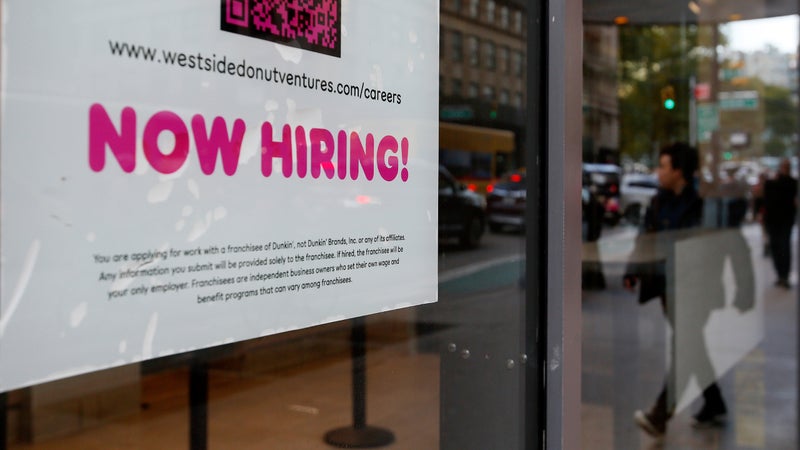Survey: Inflation has likely peaked, but consumers will still pay more this year

The Bankrate promise
At Bankrate we strive to help you make smarter financial decisions. While we adhere to strict , this post may contain references to products from our partners. Here's an explanation for .
The worst may be over when it comes to surging inflation, but consumers this year are still bound to have to pay more for the items they both need and want than they did before the pandemic, economists say.
Nearly half (or 46 percent) of economists in Bankrate’s Fourth-Quarter Economic Indicator poll say inflation will largely be as expected over the next 12-18 months. That compares with 38 percent who say inflation will cool more than expected. Prices are broadly seen as cooling from their 40-year high, but they’re unlikely to hit the Federal Reserve’s not-too-hot, not-too-cold target of 2 percent by the end of this year, according to U.S. central bank projections.
A positive sign, just 15 percent say prices will rise more significantly than expected. That’s the first time since the third quarter of 2021 that the majority of economists haven’t warned consumers that even higher prices are likely.
The findings suggest higher borrowing costs from the U.S. central bank may finally be starting to alleviate the burden of high inflation — though they likely also risk causing a different kind of pain, both in the form of raising borrowing costs and possibly kickstarting a recession.
If the Federal Reserve does raise its benchmark rate further as expected, many borrowing costs, including for credit cards and auto loans, will also edge higher. We’d strongly urge that individuals shop around for the best rates.
— Mark HamrickBankrate senior economic analyst
Key takeaways on inflation from Bankrate’s Fourth-Quarter Economic Indicator survey
- The largest cluster of economists (at 46%) say inflation will largely behave as expected over the next 12-18 months.
- 38% of survey respondents say inflation will cool more than expected.
- 15% of survey respondents say inflation will rise more significantly than expected.
- Prices so far have cooled 2 percentage points from their peak, rising 7.1% in November from a year ago after hitting a 40-year annualized high of 9.1% in June, according to the Department of Labor’s consumer price index (CPI).
- How much are prices expected to cool this year? Fed officials see their main inflation gauge — another index, personal consumption expenditures (PCE) — hitting 3.1% by the end of 2023, down almost 3 percentage points from its current level of 6%, according to the Department of Commerce.
What’s next for rampant inflation — and why consumers could feel some relief
Tracking inflation after the coronavirus pandemic has been as complicated as predicting where it’s heading. The highest price pressures in 40 years largely started as a pandemic-related supply-shock story. Shutdowns within the U.S. and around the globe kept companies from producing enough goods. That happened just as enhanced unemployment benefits and stimulus checks flooded Americans’ pocketbooks. With dining out at a restaurant or taking a vacation off limits, consumers instead spent their cash on goods — from furniture and electronics to cars, homes and appliances.
Reduced oil production and the war in Ukraine sent energy prices soaring, and the dominoes kept falling from there. With transportation more expensive and companies experiencing labor shortages after lockdowns, groceries and food prices also soared.
Today, however, inflation is more than a problem in goods, food and energy. Rents are also soaring as consumers lock in new leases that aren’t as cheap as they were after the pandemic. Rent of primary residence jumped 7.9 percent from a year ago, the biggest price burst since July 1982, according to the Department of Labor’s consumer price index (CPI).
Meanwhile, as companies in leisure and hospitality, food service and more struggle to find enough workers to fill their vacant positions, they’ve lifted up wages to lure more applicants — but then offset those wage costs by passing higher prices to consumers. Services, from health care to haircuts, are up 6.8 percent from a year ago, the largest jump since 1982, Labor Department data shows.
Fed Chair Jerome Powell has hinted that these price pressures are what worry the Fed most right now. Rent and services prices are still climbing even as overall headline inflation continues to cool.
“The Fed is focused on the dynamics of inflation in parts, and not all parts are trending in the same direction,” says Odeta Kushi, deputy chief economist at First American Financial Corporation. “The crystal ball gets cloudy when trying to predict what core services excluding shelter will look like next year. Lower consumption demand should ultimately help to put downward pressure on services inflation, but at the moment, service providers are still struggling to find labor, which is putting upward pressure on wages.”
That’s also where the Fed’s rate hikes could come in to stomp out price pressures once and for all. Higher rates tighten financial conditions and make it more expensive for companies to borrow money. Companies often defer investments or delay hiring. If consumers become less confident in their job security, they might start to pull back on spending. That reduced demand coupled with reduced hiring is what takes the edge off of rampant inflation in services.
“Favorable year-over-year energy price comparisons will provide a significant reduction to headline inflation,” says Dante DeAntonio, director of economic research at Moody’s Analytics. “As the labor market continues to cool and wage growth slows, it will also take some of the pressure off of core services inflation.”
But the inflation outlook still hinges on areas outside of monetary policymakers’ control, such as continued pandemic-related lockdowns in China and the ongoing war in Ukraine. The Fed can’t produce more oil or reopen factories; it can only bring demand into balance with limited supply.
Those factors could make high inflation even harder to break if they worsen — but if they improve more than officials expect, they could bring inflation down much quicker, too.
“Inflation will cool faster than the Federal Reserve expects, since many components, such as housing costs, have already been cooling significantly,” says Yelena Maleyev, economist at KPMG. “The upside risk to inflation is what is happening in the rest of the world, especially as China attempts to reopen after their COVID-zero policies and as Russia continues to invade Ukraine.”
Hear from the experts
Higher inflation next year will be driven by the degree of COVID resurgence on supply chains; the continuation of the Russia/Ukraine conflict on critical materials in supply chains, food, and gas; and the impact of potential Chinese trade bans on key materials in supply chains. As higher interest rates begin to have a stronger effect on the economy, it is likely to lead to a reduction in consumer expenditures, also partially due to declining real wages from inflation. The resulting decline in demand for products will help to mitigate inflation toward the end of the year.
— Nayantara Hensel, PhD, senior economic advisor, Seaborne Defense LLC
The main cause of high core inflation now is rising shelter costs, and we’re at a tipping point in rents and slowing home price increases. Both rents and home prices hit inflation with a long lag time, so their moderating effects won’t be evident until later in the year but will last well into 2024.
— Robert Frick, corporate economist, Navy Federal Credit Union
Taming services inflation will be the Fed’s biggest challenge in 2023, and we think it will be difficult to quickly bring inflation down to the 2 percent target. Unlike goods prices, services inflation is mostly influenced by the state of the domestic economy, primarily the unemployment rate, nominal wage growth and fluctuations in house prices. … The labor market will soften next year, but there is a risk that this occurs more gradually than anticipated as businesses may be reluctant to lay off workers. This could keep some upward pressure on nominal wage growth.
— Ryan Sweet, chief economist, Oxford Economics
Methodology
The Fourth-Quarter 2022 Bankrate Economic Indicator Survey of economists was conducted Dec. 12-19. Survey requests were emailed to economists nationwide, and responses were submitted voluntarily online. Responding were: Ryan Sweet, chief economist, Oxford Economics; Yelena Maleyev, economist, KPMG LLP; Odeta Kushi, deputy chief economist, First American Financial Corporation; Lawrence Yun, chief economist, National Association of Realtors; Scott Anderson, executive vice president and chief economist, Bank of the West; Bernard Markstein, president and chief economist, Markstein Advisors; Mike Englund, chief economist, Action Economics; John E. Silvia, founder and president, Dynamic Economic Strategies; Robert Frick, corporate economist, Navy Federal Credit Union; Dante DeAntonio, director of economic research, Moody’s Analytics; Nayantara Hensel, PhD, senior economic advisor, Seaborne Defense LLC; Gregory Daco, chief economist, EY; and Bill Dunkelberg, chief economist, National Federation of Independent Businesses.
